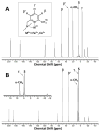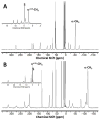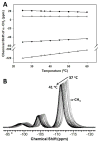Six-coordinate Iron(II) and Cobalt(II) paraSHIFT Agents for Measuring Temperature by Magnetic Resonance Spectroscopy
- PMID: 26716610
- PMCID: PMC5555598
- DOI: 10.1021/acs.inorgchem.5b02144
Six-coordinate Iron(II) and Cobalt(II) paraSHIFT Agents for Measuring Temperature by Magnetic Resonance Spectroscopy
Abstract
Paramagnetic Fe(II) and Co(II) complexes are utilized as the first transition metal examples of (1)H NMR shift agents (paraSHIFT) for thermometry applications using Magnetic Resonance Spectroscopy (MRS). The coordinating ligands consist of TACN (1,4,7-triazacyclononane) and CYCLEN (1,4,7,10-tetraazacyclododecane) azamacrocycles appended with 6-methyl-2-picolyl groups, denoted as MPT and TMPC, respectively. (1)H NMR spectra of the MPT- and TMPC-based Fe(II) and Co(II) complexes demonstrate narrow and highly shifted resonances that are dispersed as broadly as 440 ppm. The six-coordinate complex cations, [M(MPT)](2+) and [M(TMPC)](2+), vary from distorted octahedral to distorted trigonal prismatic geometries, respectively, and also demonstrate that 6-methyl-2-picolyl pendents control the rigidity of these complexes. Analyses of the (1)H NMR chemical shifts, integrated intensities, line widths, the distances obtained from X-ray diffraction measurements, and longitudinal relaxation time (T1) values allow for the partial assignment of proton resonances of the [M(MPT)](2+) complexes. Nine and six equivalent methyl protons of [M(MPT)](2+) and [M(TMPC)](2+), respectively, produce 3-fold higher (1)H NMR intensities compared to other paramagnetically shifted proton resonances. Among all four complexes, the methyl proton resonances of [Fe(TMPC)](2+) and [Co(TMPC)](2+) at -49.3 ppm and -113.7 ppm (37 °C) demonstrate the greatest temperature dependent coefficients (CT) of 0.23 ppm/°C and 0.52 ppm/°C, respectively. The methyl groups of these two complexes both produce normalized values of |CT|/fwhm = 0.30 °C(-1), where fwhm is full width at half-maximum (Hz) of proton resonances. The T1 values of the highly shifted methyl protons are in the range of 0.37-2.4 ms, allowing rapid acquisition of spectroscopic data. These complexes are kinetically inert over a wide range of pH values (5.6-8.6), as well as in the presence of serum albumin and biologically relevant cations and anions. The combination of large hyperfine shifts, large temperature sensitivity, increased signal-to-noise ratio, and short T1 values suggests that these complexes, in particular the TMPC-based complexes, show promise as paraSHIFT agents for thermometry.
Figures






Similar articles
-
Fe(ii) and Co(ii) N-methylated CYCLEN complexes as paraSHIFT agents with large temperature dependent shifts.Dalton Trans. 2018 Jan 15;47(3):916-924. doi: 10.1039/c7dt03812g. Dalton Trans. 2018. PMID: 29260180
-
Seven-coordinate Co(II), Fe(II) and six-coordinate Ni(II) amide-appended macrocyclic complexes as ParaCEST agents in biological media.Inorg Chem. 2014 Aug 18;53(16):8311-21. doi: 10.1021/ic5006083. Epub 2014 May 13. Inorg Chem. 2014. PMID: 24820102 Free PMC article.
-
Mononuclear [(BP)(2)MX](n+) (M = Cu(2+), Co(2+), Zn(2+); X = OH(2), Cl(-)) complexes with a new biphenyl appended N-bidentate ligand: structural, spectroscopic, solution equilibrium and ligand dynamic studies.Dalton Trans. 2009 Nov 28;(44):9770-80. doi: 10.1039/b910519k. Epub 2009 Sep 28. Dalton Trans. 2009. PMID: 19885522
-
Six, Seven or Eight Coordinate Fe(II) , Co(II) or Ni(II) Complexes of Amide-Appended Tetraazamacrocycles for ParaCEST Thermometry.Chemistry. 2015 Dec 7;21(50):18290-300. doi: 10.1002/chem.201503125. Epub 2015 Oct 23. Chemistry. 2015. PMID: 26494320 Free PMC article.
-
Gear Up for a pH Shift: A Responsive Iron(II) 2-Amino-6-picolyl-Appended Macrocyclic paraCEST Agent That Protonates at a Pendent Group.Inorg Chem. 2016 Nov 21;55(22):12001-12010. doi: 10.1021/acs.inorgchem.6b02159. Epub 2016 Nov 4. Inorg Chem. 2016. PMID: 27934305 Free PMC article.
Cited by
-
Chemistry of MRI Contrast Agents: Current Challenges and New Frontiers.Chem Rev. 2019 Jan 23;119(2):957-1057. doi: 10.1021/acs.chemrev.8b00363. Epub 2018 Oct 16. Chem Rev. 2019. PMID: 30350585 Free PMC article. Review.
-
Paramagnetic Properties and Moderately RapidConformational Dynamics in the Cobalt(II) Calix[4]arene Complex by NMR.Molecules. 2022 Jul 21;27(14):4668. doi: 10.3390/molecules27144668. Molecules. 2022. PMID: 35889541 Free PMC article.
-
Human Serum Albumin-Inspired Glycopeptide-Based Multifunctional Inhibitor of Amyloid-β Toxicity.ACS Omega. 2020 Jul 20;5(30):18628-18641. doi: 10.1021/acsomega.0c01028. eCollection 2020 Aug 4. ACS Omega. 2020. PMID: 32775865 Free PMC article.
-
Physical properties, ligand substitution reactions, and biological activity of Co(iii)-Schiff base complexes.Dalton Trans. 2019 May 7;48(18):5987-6002. doi: 10.1039/c8dt04606a. Dalton Trans. 2019. PMID: 30672949 Free PMC article.
-
Comparison of phosphonate, hydroxypropyl and carboxylate pendants in Fe(III) macrocyclic complexes as MRI contrast agents.J Inorg Biochem. 2021 Dec;225:111594. doi: 10.1016/j.jinorgbio.2021.111594. Epub 2021 Aug 28. J Inorg Biochem. 2021. PMID: 34517167 Free PMC article.
References
-
- Datta NR, Ordonez SG, Gaipl US, Paulides MM, Crezee H, Gellermann J, Marder D, Puric E, Bodis S. Cancer Treat Rev. 2015;41:742. - PubMed
-
- Wust P, Hildebrandt B, Sreenivasa G, Rau B, Gellermann J, Riess H, Felix R, Schlag PM. Lancet Oncol. 2002;3:487. - PubMed
-
- Waterman FM. In: Thermoradiotherapy and Thermochemotherapy. Seegenschmiedt MH, Fessenden P, Vernon C, editors. Springer; Berlin Heidelberg: 1995. p. 331.
-
- Quesson B, de Zwart JA, Moonen CTW. J Magn Reson Imaging. 2000;12:525. - PubMed
-
- Orenstein A, Kostenich G, Tsur H, Kogan L, Malik Z. Cancer Lett. 1995;93:227. - PubMed
Publication types
MeSH terms
Substances
Grants and funding
LinkOut - more resources
Full Text Sources
Other Literature Sources
Medical

